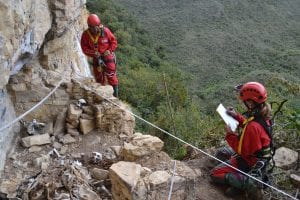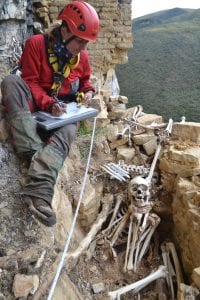Vertical Archaeology Explores Tomb Secrets
 This summer, J. Marla Toyne, Ph.D., Assistant Professor in the UCF Anthropology Department, will return to the high jungle of Peru to continue her research of ancient tombs. However, instead of digging down to uncover remains, she and her team will climb and rappel along mountain ridges, plateaus, and narrow cliffs.
This summer, J. Marla Toyne, Ph.D., Assistant Professor in the UCF Anthropology Department, will return to the high jungle of Peru to continue her research of ancient tombs. However, instead of digging down to uncover remains, she and her team will climb and rappel along mountain ridges, plateaus, and narrow cliffs.
The ancient Chachapoya people of Peru (AD 900-1470) buried their dead in these elaborate cliff tombs they built using narrow ledges as foundations. They constructed masonry platforms and open chamber tombs that would hold many family members hundreds of meters above deep canyons. This site called La Petaca has over 100 tomb structures across at least 6 ledges.
Dr. Toyne will continue her exploration of these tombs at La Petaca with her research funded by the Committee for Research and Exploration of the National Geographic Society, the Rust Foundation and the Petzl Foundation. This site is located in the northeastern mountainous region in a dense, subtropical environment more than 3,000 meters above sea level.
In 2013, Dr. Toyne led a successful first-of-its-kind study at La Petaca with her team including vertical rope access professionals from Spain, a local Peruvian archaeologist, and two UCF students. The bioarchaeological research project involved archaeological mapping and documentation of the mortuary structures and the recovery of the human skeletal remains to explore questions of who was buried in these tombs – their lifestyle, diet, and health patterns. While most of the tombs had been looted and their contents destroyed or removed, Dr. Toyne and her team examined the remains to count how many people could have been in each tomb and the possible age and sex distribution. They also took organic samples for radiocarbon dating and determined that the site was constructed and used for over 600 years (from AD 900 to 1550). This fundamental research provided the basis for her upcoming project and was influential in acquiring additional financial support.
 In the upcoming research project at La Petaca, Dr. Toyne and her team will continue the same research with the detailed analysis and recording of a select number of tombs, their architecture and contents. They plan to use funding for more radiocarbon dates to define the site’s usage and construction sequence and also incorporate innovative 3D modelling using photogrammetry to create digital reconstructions of a select number of tombs. Their goal is to create a visual representation – a photographic map of the site and allow select sites to be seen up close and in detail. These visual representations are comparable to a digital site map that can be linked to what is known about these different structures.
In the upcoming research project at La Petaca, Dr. Toyne and her team will continue the same research with the detailed analysis and recording of a select number of tombs, their architecture and contents. They plan to use funding for more radiocarbon dates to define the site’s usage and construction sequence and also incorporate innovative 3D modelling using photogrammetry to create digital reconstructions of a select number of tombs. Their goal is to create a visual representation – a photographic map of the site and allow select sites to be seen up close and in detail. These visual representations are comparable to a digital site map that can be linked to what is known about these different structures.
“The broad goal is to understand the history and social complexity defined in the tombs variation and also the nature of the human population that was interred at the site overtime,” explained Dr. Toyne. “What was life like for these people and why would they have expended such effort to build these burial sites in such a precarious environment?”
This challenging field work requires professional technical assistance for safety and security from rope access specialists or vertical progression technicians. For this reason the research style is termed “vertical archaeology” to describe the combination of archaeological methods with vertical access technology and safety. The team descends the cliff using rope systems to move horizontally and vertically across the wall and ledges. The tombs are by definition inaccessible without this modern technology and drives the question of how and why these ancient people would choose to invest and risk so much in the creation of these tombs.
modern technology and drives the question of how and why these ancient people would choose to invest and risk so much in the creation of these tombs.
Dr. Toyne and her team aim to continue working closely with the local communities to inform them of their research goals but also to explain the precarious nature of the environment and not to bring tourists around for visits.
“While these tombs have withstood the tests of time, current climatic conditions and general degradation of the rock are clearly causing structures to collapse,” Dy. Toyne explained. “Rampant looting in the 1990s destroyed many tombs and removed most of the archaeological remains (mummies, ceramics, artifacts) but the materials that remain still contain invaluable information, and so we race against time to recover these incredible vestiges of a past people who believed the dead deserved such a spectacular view of the world around them.”
Dr. Toyne and her team will continue this research in June and July this summer.
